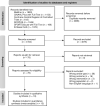Smartphone applications for physical activity and sedentary behaviour change in people with cardiovascular disease: A systematic review and meta-analysis
- PMID: 34634096
- PMCID: PMC8504773
- DOI: 10.1371/journal.pone.0258460
Smartphone applications for physical activity and sedentary behaviour change in people with cardiovascular disease: A systematic review and meta-analysis
Abstract
Background: Smartphone applications provide new opportunities for secondary prevention healthcare. This systematic review and meta-analysis aimed to determine if smartphone applications are effective at changing physical activity and sedentary behaviour in people with cardiovascular disease.
Methods: Six electronic databases (Medline, CINAHL Plus, Cochrane Library, SCOPUS, Sports Discus and EMBASE) were searched from 2007 to October 2020. Cardiovascular disease secondary prevention physical activity or sedentary behaviour interventions were included where the primary element was a smartphone or tablet computer application (excluding SMS-only text-messaging). Study quality was assessed using validated tools appropriate for each study design. Random effects model was used and the pooled mean difference between post scores were calculated. Subgroup analyses were conducted to examine differences based on diagnosis, sample size, age, intervention duration, activity tracker use, target behaviour, and self-report versus device-measured outcome.
Results: Nineteen studies with a total of 1,543 participants were included (coronary heart disease, n = 10; hypertension, n = 4; stroke, n = 3; heart failure, n = 1; peripheral artery disease, n = 1). Risk of bias was rated as high. Thirteen studies were included in the meta-analysis. Only two controlled studies reported on sedentary behaviour. Smartphone applications produced a significant increase of 40.35 minutes of moderate-to-vigorous intensity physical activity per week (7 studies; p = 0.04; 95% CI 1.03 to 79.67) and 2,390 steps per day (3 studies; p = 0.0007; 95% CI 1,006.9 to 3,791.2). Subgroup analyses found no difference when comparing diagnoses, sample size, activity tracker use, target behaviour and self-report versus device-measured outcome. Larger improvements in physical activity were noted in intervention durations of ≤3-months and participants ≥60yrs (95.35 mins.week-1; p = 0.05).
Conclusions: Smartphone applications were effective in increasing physical activity in people with cardiovascular disease. Caution is warranted for the low-quality evidence, small sample and larger coronary heart disease representation. More rigorous research is needed to investigate the effect of smartphone applications across diagnoses and in sedentary behaviour.
Conflict of interest statement
The authors have declared that no competing interests exist.
Figures






Similar articles
-
Can Smartphone Apps Increase Physical Activity? Systematic Review and Meta-Analysis.J Med Internet Res. 2019 Mar 19;21(3):e12053. doi: 10.2196/12053. J Med Internet Res. 2019. PMID: 30888321 Free PMC article.
-
Interventions outside the workplace for reducing sedentary behaviour in adults under 60 years of age.Cochrane Database Syst Rev. 2020 Jul 17;7(7):CD012554. doi: 10.1002/14651858.CD012554.pub2. Cochrane Database Syst Rev. 2020. PMID: 32678471 Free PMC article.
-
Workplace pedometer interventions for increasing physical activity.Cochrane Database Syst Rev. 2020 Jul 21;7(7):CD009209. doi: 10.1002/14651858.CD009209.pub3. Cochrane Database Syst Rev. 2020. PMID: 32700325 Free PMC article.
-
Interventions for reducing sedentary behaviour in people with stroke.Cochrane Database Syst Rev. 2021 Jun 29;6(6):CD012996. doi: 10.1002/14651858.CD012996.pub2. Cochrane Database Syst Rev. 2021. PMID: 34184251 Free PMC article.
-
Mobile phone-based interventions for improving adherence to medication prescribed for the primary prevention of cardiovascular disease in adults.Cochrane Database Syst Rev. 2021 Mar 26;3(3):CD012675. doi: 10.1002/14651858.CD012675.pub3. Cochrane Database Syst Rev. 2021. PMID: 33769555 Free PMC article.
Cited by
-
Supervised exercise after minor stroke: an evaluation from the perspective of patients and healthcare professionals.J Rehabil Med. 2025 Mar 24;57:jrm42881. doi: 10.2340/jrm.v57.42881. J Rehabil Med. 2025. PMID: 40126426 Free PMC article.
-
Behaviour change techniques in cardiovascular disease smartphone apps to improve physical activity and sedentary behaviour: Systematic review and meta-regression.Int J Behav Nutr Phys Act. 2022 Jul 7;19(1):81. doi: 10.1186/s12966-022-01319-8. Int J Behav Nutr Phys Act. 2022. PMID: 35799263 Free PMC article.
-
Benchmarking the clinical outcomes of Healthentia SaMD in chronic disease management: a systematic literature review comparison.Front Public Health. 2024 Dec 24;12:1488687. doi: 10.3389/fpubh.2024.1488687. eCollection 2024. Front Public Health. 2024. PMID: 39776481 Free PMC article.
-
Digital Apps to Improve Mobility in Adults with Neurological Conditions: A Health App-Focused Systematic Review.Healthcare (Basel). 2024 Apr 30;12(9):929. doi: 10.3390/healthcare12090929. Healthcare (Basel). 2024. PMID: 38727486 Free PMC article. Review.
-
Umbrella review of social inequality in digital interventions targeting dietary and physical activity behaviors.NPJ Digit Med. 2025 Jan 6;8(1):11. doi: 10.1038/s41746-024-01405-0. NPJ Digit Med. 2025. PMID: 39762352 Free PMC article.
References
-
- World Health Organization. Cardiovascular Diseases (CVDs) 2017 [cited 2021 14 July]. Available from: https://www.who.int/en/news-room/fact-sheets/detail/cardiovascular-disea....
-
- Scherrenberg M, Wilhelm M, Hansen D, Völler H, Cornelissen V, Frederix I, et al.. The future is now: a call for action for cardiac telerehabilitation in the COVID-19 pandemic from the secondary prevention and rehabilitation section of the European Association of Preventive Cardiology. European journal of preventive cardiology. 2021;28(5):524–40. - PMC - PubMed

